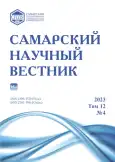Post-war Soviet elections 1947–1953: features of conduct and social significance (based on materials from the city of Gorky)
- Authors: Abrakova T.A.1, Shlyakhov M.Y.2
-
Affiliations:
- Nizhny Novgorod State University of Architecture and Civil Engineering
- Minin Nizhny Novgorod State Pedagogical University
- Issue: Vol 12, No 4 (2023)
- Pages: 159-164
- Section: Historical Sciences
- URL: https://journals.rcsi.science/2309-4370/article/view/260652
- DOI: https://doi.org/10.55355/snv2023124206
- ID: 260652
Cite item
Full Text
Abstract
The article examines the features of the conduct and social significance of elections to Soviet authorities in 1947–1953. The importance of studying this topic is associated with the need to study the state of Soviet society during the designated period. The study of elections to local authorities allows us to reconstruct the tasks that the Soviet authorities set when conducting election campaigns, the features of their conduct in different localities, the reaction of citizens, their orders and expectations from election campaigns and electoral actions. In the course of the study, using new data from archival documents, it was possible to establish the dates and features of the election campaigns to the Soviet authorities in 1947, 1950, 1953. It was noted that regular election campaigns contributed to increasing the political knowledge of citizens, introducing them to Soviet political culture, and also formed a «positive image» of the authorities in the eyes of Soviet citizens. At the same time, election campaigns revealed that Soviet citizens had a number of critical comments about the nominated deputies, which suggests the existence of dissatisfaction with certain aspects of everyday life that did not affect the main directions of Soviet state policy.
Full Text
##article.viewOnOriginalSite##About the authors
Tatiana A. Abrakova
Nizhny Novgorod State University of Architecture and Civil Engineering
Email: tatyana.abrakova@mail.ru
candidate of historical sciences, associate professor of History, Philosophy, Pedagogy and Psychology Department
Russian Federation, Nizhny NovgorodMikhail Y. Shlyakhov
Minin Nizhny Novgorod State Pedagogical University
Author for correspondence.
Email: mik-shlyakhov@yandex.ru
candidate of historical sciences, associate professor of History of Russia and Auxiliary Historical Disciplines Department
Russian Federation, Nizhny NovgorodReferences
- Звягольский А.Ю., Турицын И.В., Упоров И.В., Епифанцев А.А. Местные Советы депутатов трудящихся в послевоенное время (1945–1953 гг.): организационно-правовые основы формирования и деятельности: монография. М.: НИИ ИЭП, 2016. 131 с.
- Палазян А.С. Правовое регулирование института местных Советов депутатов трудящихся в послевоенный период // Общество и право. 2012. № 5 (42). С. 35–38.
- Кимерлинг А.С. Выборы в Верховный Совет СССР 1946 г. в Молотовской области как пример мобилизационной политической кампании // Вестник Пермского университета. Сер. «История». 2016. № 4 (35). С. 104–114. doi: 10.17072/2219-3111-2016-4-104-114.
- Хасянов О.Р., Бравина М.А. Наказы избирателей как репрезентация повседневных проблем послевоенного сельского социума Куйбышевской области (1947) // Научный диалог. 2020. № 9. С. 469–482. doi: 10.24224/2227-1295-2020-9-469-482.
- Колязимова М.М. Идеолого-пропагандистские кампании, связанные с подготовкой к выборам в Верховный Совет СССР 1946 г. (по материалам Кемеровской области) // Вестник Кемеровского гуманитарного университета. 2013. № 4 (56), т. 2. С. 33–36.
- Генина Е.С., Колязимова М.М. Идеологические кампании в Западной Сибири 1945–1953 гг. (современная отечественная историография проблемы) // Вестник Кемеровского государственного университета. 2016. № 3 (67). С. 14–21. doi: 10.21603/2078-8975-2016-3-14-21.
- Абракова Т.А., Гордин А.А., Шляхов М.Ю. Выборы в Верховный Совет СССР 1946 года в городе Горьком: организация и отношение общества // Вопросы истории. 2022. № 4 (2). С. 41–54. doi: 10.31166/voprosyistorii202204statyi51.
- Абракова Т.А., Шляхов М.Ю. Человек в контексте послевоенной повседневности: 1945–1948 годы (по материалам города Горького) // Современная научная мысль: научный журнал истории, экономики и права. 2021. № 4. С. 121–129. doi: 10.24412/2308-264x-2023-4-89-94.
- Государственный общественно-политический архив Нижегородской области (ГУ ГОПАНО). Ф. 30. Оп. 1. Д. 3343, 3893.
- ГУ ГОПАНО. Ф. 30. Оп. 1. Д. 3837, 3842, 3889.
- ГУ ГОПАНО. Ф. 30. Оп. 1. Д. 3842. Л. 93.
- ГУ ГОПАНО. Ф. 30. Оп. 1. Д. 3842. Л. 79.
- ГУ ГОПАНО. Ф. 30. Оп. 1. Д. 3893. Л. 177.
- ГУ ГОПАНО. Ф. 30. Оп. 1. Д. 3842. Л. 61–62.
- ГУ ГОПАНО. Ф. 30. Оп. 1. Д. 3842. Л. 3.
- ГУ ГОПАНО. Ф. 30. Оп. 1. Д. 3893. Л. 45.
- ГУ ГОПАНО. Ф. 30. Оп. 1. Д. 3842. Л. 63.
- ГУ ГОПАНО. Ф. 30. Оп. 1. Д. 3842. Л. 1.
- ГУ ГОПАНО. Ф. 30. Оп. 1. Д. 3842. Л. 1–3.
- ГУ ГОПАНО. Ф. 30. Оп. 1. Д. 3842. Л. 2.
- ГУ ГОПАНО. Ф. 30. Оп. 1. Д. 3842. Л. 54, 55.
- ГУ ГОПАНО. Ф. 30. Оп. 1. Д. 3842. Л. 45.
- ГУ ГОПАНО. Ф. 30. Оп. 1. Д. 3842. Л. 21.
- ГУ ГОПАНО. Ф. 30. Оп. 1. Д. 3889, 3890, 3893.
- ГУ ГОПАНО. Ф. 30. Оп. 1. Д. 3889. Л. 94–110.
- ГУ ГОПАНО. Ф. 30. Оп. 1. Д. 3893. Л. 42, 45, 46.
- ГУ ГОПАНО. Ф. 30. Оп. 11. Д. 83. Л. 6, 12, 46.
- Зубкова Е.Ю. Послевоенное советское общество: политика и повседневность. 1945–1953. М.: РоссПЭн, 1999. 229 с.
Supplementary files






